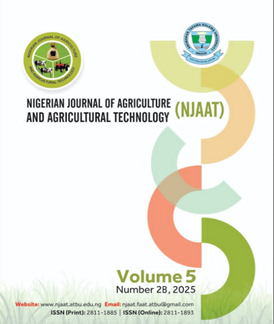PREVALENCE OF FASCIOLIASIS AMONG RUMINANT SPECIES IN SELECTED ABATOIRS IN JOS NORTH PLATEAU STATE, NIGERIA
Keywords:
Fasciolias, Ruminants, Prevalence, Risk, FactorsAbstract
The study assessed the prevalence fascioliasis among ruminant animals slaughtered in three major abattoirs of Jos Central, Bulbula, and Yan-Ganda in Jos, Plateau State, Nigeria. A total of 3,510 samples were examined, with an overall prevalence rate of 10.50%. Jos Central recorded the highest prevalence (12.80%): followed by Yan-Ganda (10.20%) and Bulbula (8.50%). Prevalence was analyzed by sex, season, and breed. Males showed higher infection rates across all species, sheep (24.5%) and goats (15.2%) at Yan-Ganda. Odds ratio (OR) analysis confirmed higher risk in males, especially goats (OR = 2.36) and sheep (OR = 1.92), the Chi-square test showed no significant association (χ² = 0.24; P > 0.05). Seasonally, infection rates peaked during the rainy season across all abattoirs, with the highest in cattle at Yan-Ganda (22.2%). Goats showed an increased risk during the rainy season (OR = 1.71), this was not statistically significant (χ² = 1.33; p > 0.05). Breed analysis revealed higher infection rates in White Fulani (23.03%) and Red Bororo (22.02%) cattle, as well as in Red Sokoto goats and Uda sheep. In conclusion, fascioliasis remains prevalent among ruminants in Plateau State, with variations influenced by sex, age, season and breed. Targeted control measures especially deworming programs for high-risk groups are recommended. Further studies should investigate environmental and seasonal factors affecting transmission to enhance preventive strategies in the region.
Downloads
Downloads
Published
How to Cite
Issue
Section
License
Copyright (c) 2025 Nigerian Journal of Agriculture and Agricultural Technology

This work is licensed under a Creative Commons Attribution-NonCommercial-ShareAlike 4.0 International License.
This work is licensed under a CC Attribution-NonCommercial-ShareAlike 4.0



